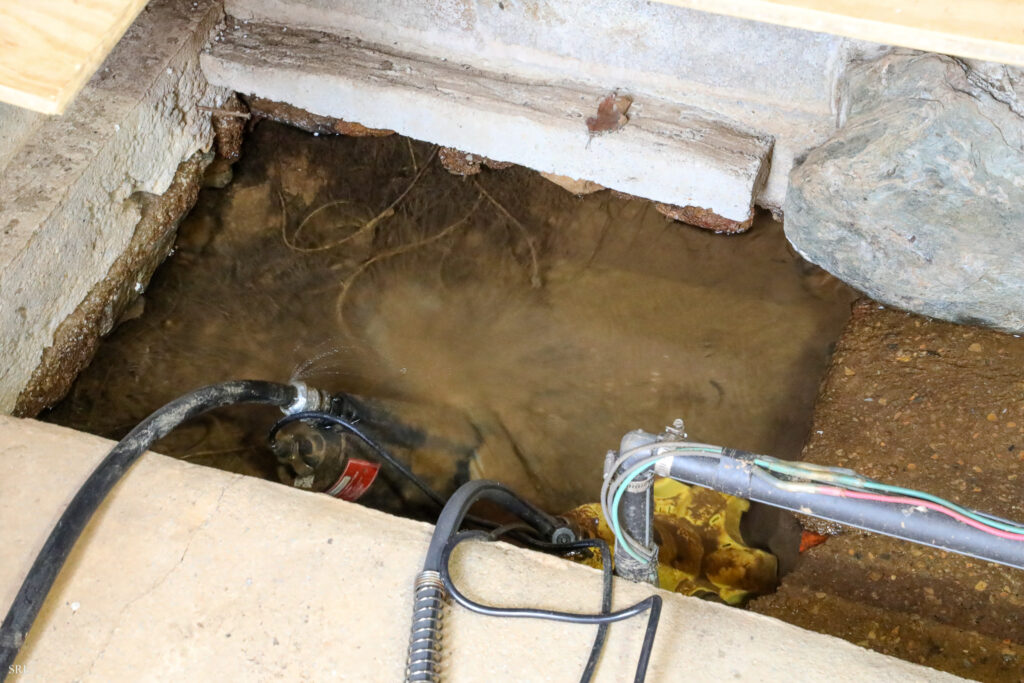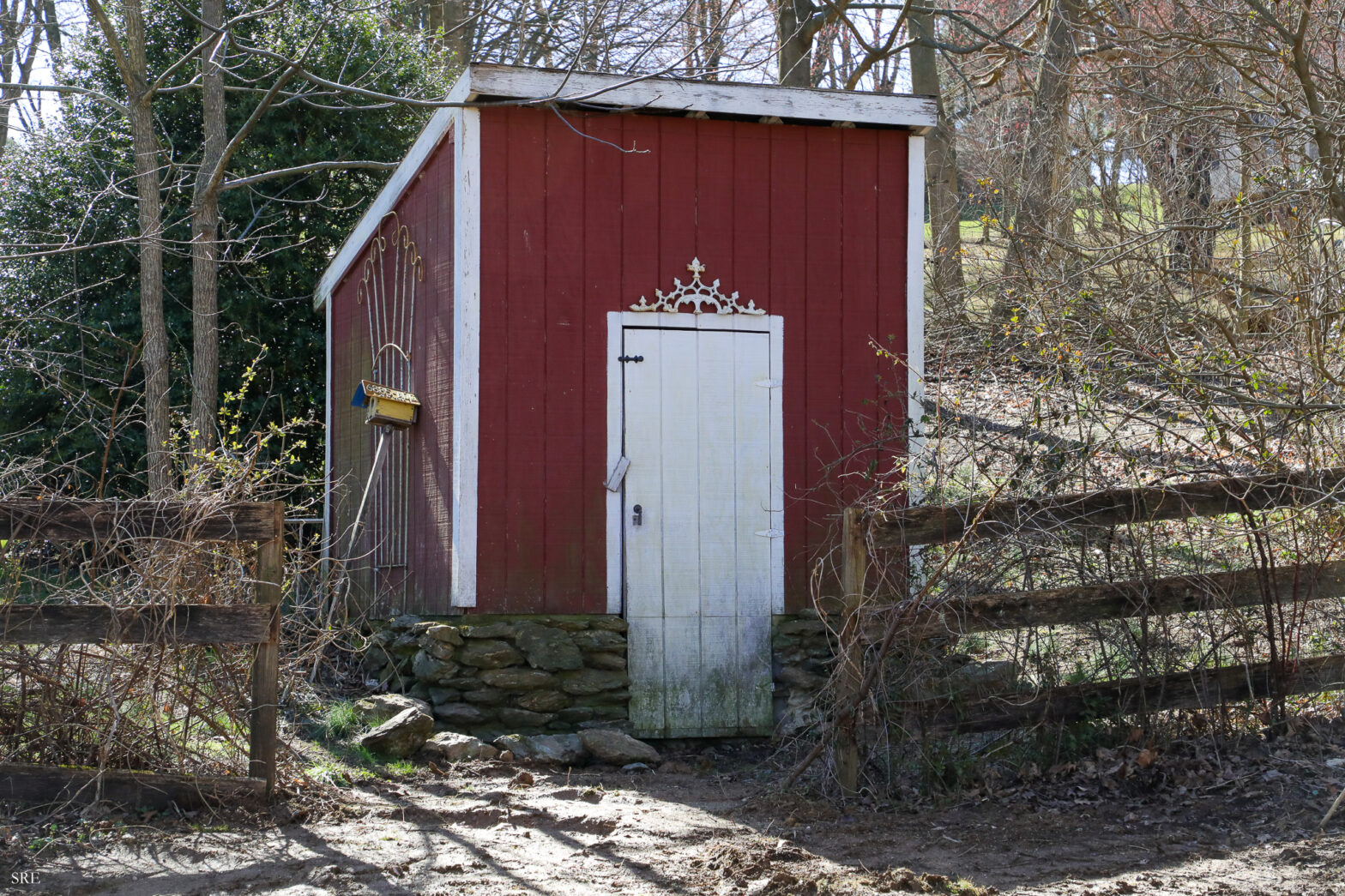“The selection of a site for a new farm was always based, in part, on the availability of a good supply of clean, cold water. ‘I’ve got a good, bold spring,’ is a sentence we have heard a hundred times, and it is always said with pride and satisfaction.” – Fox Fire, book no. 4.
The outflow pipe of our springhouse failed and I quickly learned why old timers of previous generations made it priority to protect their water sources. Whether it be the inlet, basin or outflow, they did best to keep it in healthy working order by means of enclosure. Wall and roof evolved to protect and isolate the spring, allowing for more reliable access to clean cold water. This was and still is a matter of first principles; the lifeblood of homesteader potential and success, when nurtured and cultivated this water source was a vital ingredient to health and prosperity.


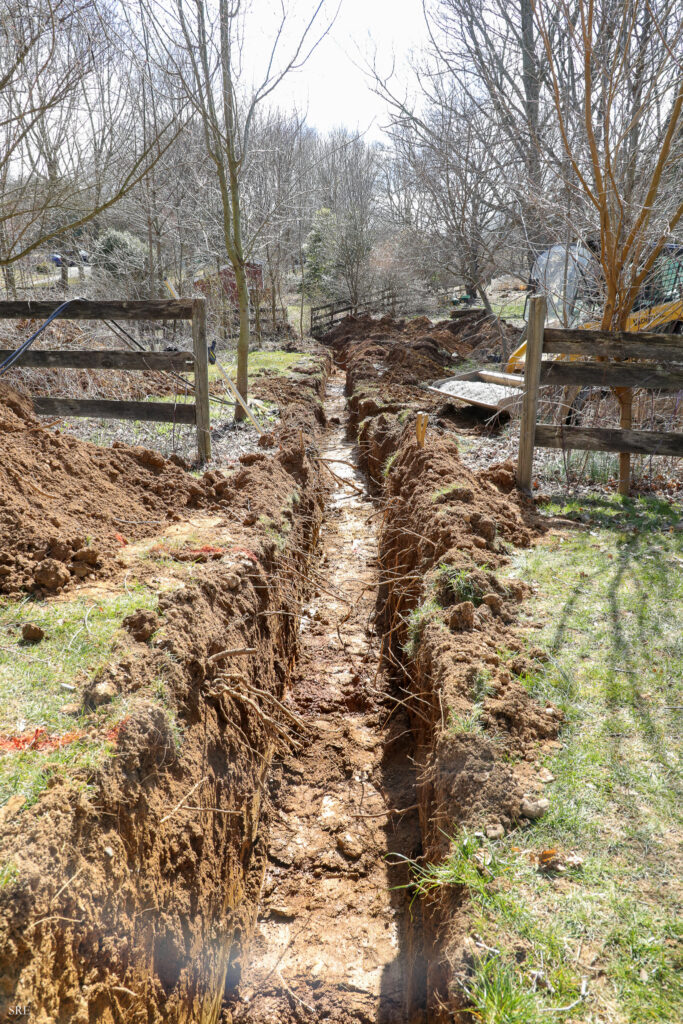
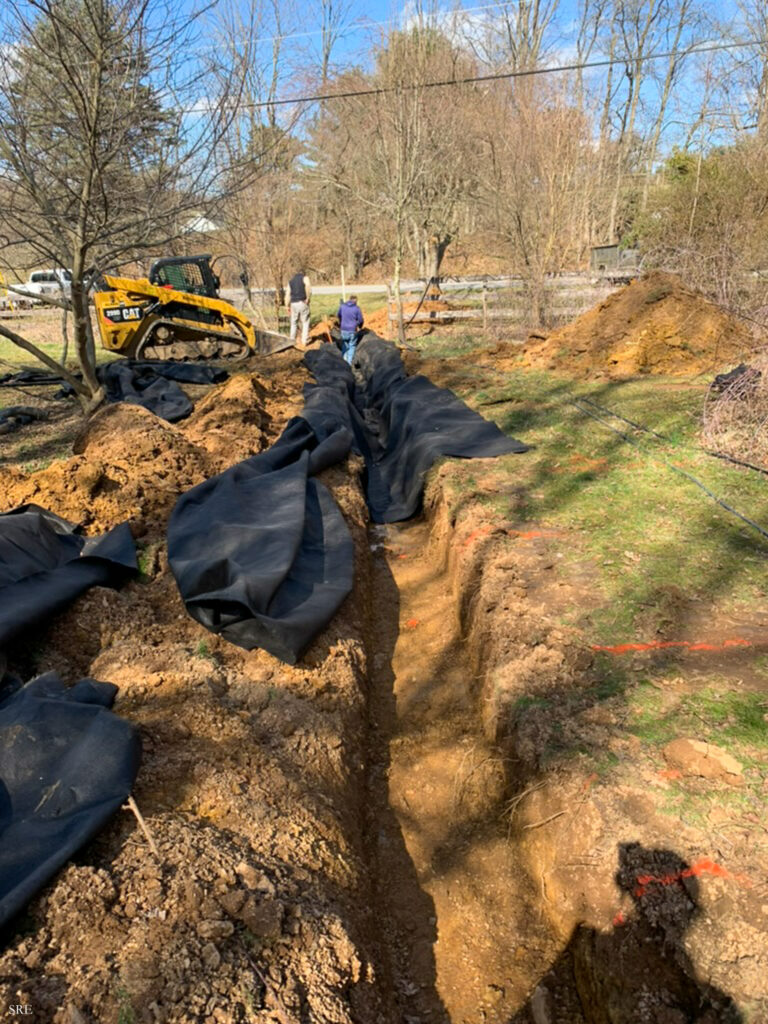
Our spring was and still is no different, it comes out of the earth from a singular point in rocky broken ground on a softly falling hillside. Like many others that populate my area, it issues forth because the slope of the ground (or grade) is steeper than the water table underground. That’s the definition of a spring. Where these two lines intersect is the genesis of running water. For what we believe to be about two centuries, our spring has been fully enclosed in a stone foundation 24” in height to the tallest point. Atop the stone is wood framed walls with a shed style shingle roof pitched toward the rear uphill elevation. The whole of the wood is painted red with white trim and door, matching the color palette of barn and outbuildings. It is of the typical rectangular boarded structure – efficient and functional in practical design- which is frequently seen banked within the hillsides close to the main house on farm or homestead. There are many iterations across America and beyond; the many differing kinds representing the long standing value we place on clean cold water.
Outside of the stone foundation on the northerly facing side of our springhouse, the basin flows outside to a gravel trough and into a 5” cast iron pipe. The grade naturally slopes downhill and from this pipe the eventual route transitions through two different confluences with other springs on the property before the final destination astream, which is a tributary to the headwaters of our local trouty tailwater. For this fact is why the importance is compounded: brook trout spawn in this tributary and it is quite the feat, navigating through modern farmland basins and a bottomland filled with predators, some natural but mostly man-made, onward through still plentiful clean cold waters rich in plants and aquatic insects. Seems like a small bit of the pristine, partitioned on all sides by modern agriculture. A rarity, possibly ephemeral.
The 5.5 gallons per minute this stream receives from the water that comes out of our springhouse is an important factor to the sustenance of my local salvelinus fontinalis. They are why it became priority to restore this drainage; 5.5 gpm is a lot of water coming from a single source, especially when it just appears out of the side of a hill. Once in time it obviously did run overland, but it’s been part of the subterranean network for so long that the water and topography evolved around this configuration. It seemed quite natural to fix this. Plus, I like seeing brookies and knowing they are on our property in the stream, seeing their redds excavated and observing what speed of water they prefer, the depth and water temperature metrics, the subtle cyclical changes they make, and so on. It’s been satisfying and interesting to watch for a few years running now. The spring is important to me. It seems apparent the water would eventually get to where it wants to go, the stream progressing to the river, but it wouldn’t be quite the same and as direct if left above ground; there would be losses. Loss of water quantity translates into thermal gains; we don’t want our waters any warmer…. These were my internal justifications.

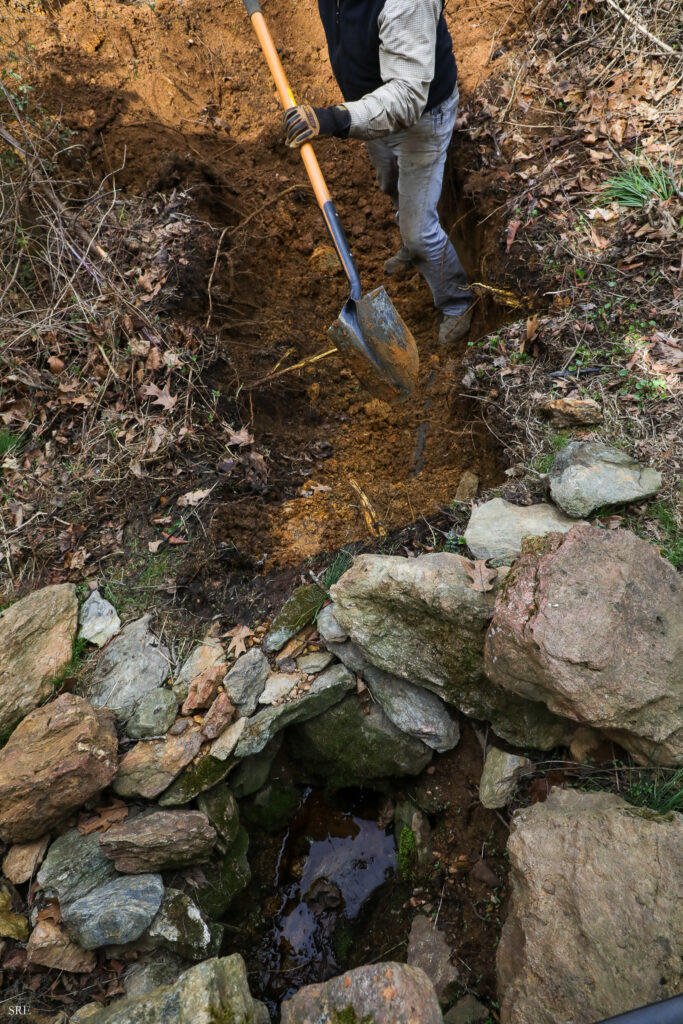
So:
Somewhere along the watercourse described above the underground pipe failed, causing almost a total backup of 5.5 gpm of 53 degree spring water to flow overtop the outside catchment basin and create a small wetland area on our property. I say small because I caught the failure about 3 days after it happened (we were out of town) but its interesting to note the affect the water had on the land by running over it and not through it. Just a few days time, it was a completely different little ecosystem. A change occurred that felt too big for the size, when water runs over something for long enough you seem to understand it a bit better. This case being the topography – I saw where everything is eventually heading. It confirmed things, it’s changed things; on my property any water that lands on or in it is traveling in a newly recognized northwesterly direction and into the stream. Of course we understand this to be a ubiquitous law: things trend towards moving downhill, what I’m saying is the original path may not be exactly as it appears. And that brings up the question of how much man can change the land, landscape, and environment by altering how water moves through it. In my situation it was apparent and on real-time display; almost like understanding something by taking it apart or seeing it broken for a while just to heal again.
Yes, we had water issues… we didn’t know where the pipe was blocked and assuming it was a single long length of hard-pipe to the confluence collection trough (a large concrete box drain along the roadway owned by the county I live in) I assumed we needed to clear a blockage and use the volume and weight of the water to force itself free; by pressure of the volume of flow it would self correct. I was wrong.
It didn’t go quite like that at all, and I won’t get into the minutia of diagnosing what and how this all failed other than to say we came to the determination that whatever was underground was broken and needed completely replaced. So lets tear it all out and do it right as per today’s standards.

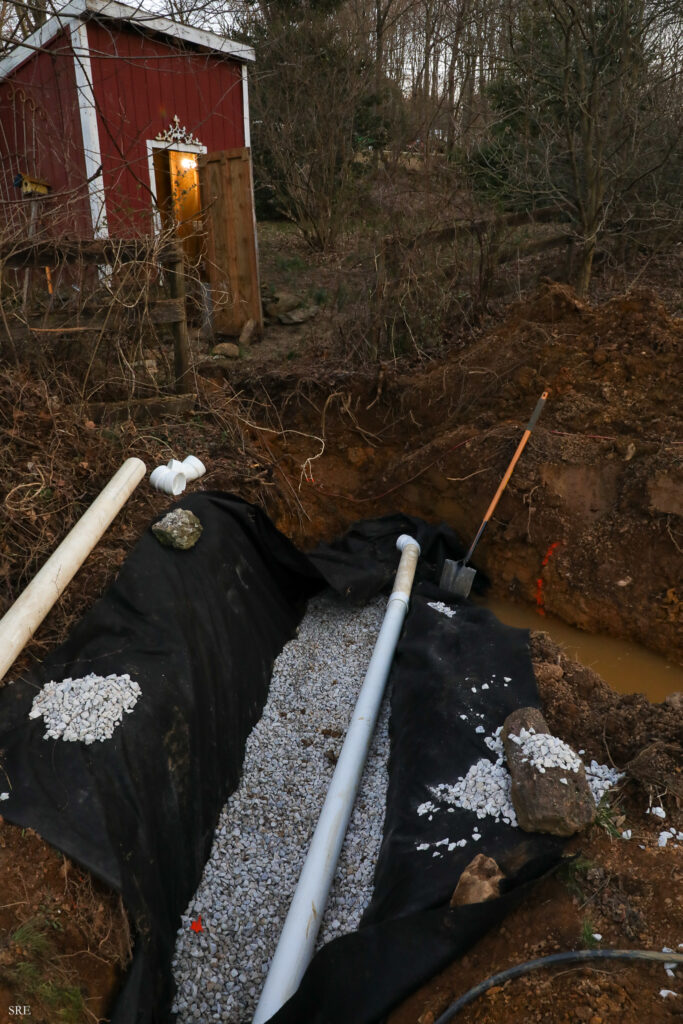
What we found and how it broke:
It took a Caterpillar 308 mini-excavator and skid steer of the same make to start excavation and demolition. What we found was newer in age than expected, maybe 15 to 20 years old. The previous owner must have had issues and replaced the drain system too. They did so by way of a water mitigation installation called a drainage field, which we won’t be putting back. Much like the drain-tile systems that are used in modern building practices, this 4” perforated black plastic pipe gets wrapped in small stones which is buried underground. This creates a path of least resistance for the water to travel and it allows for easier underground manipulation such as direction and elevation changes. Water pressure is an interesting thing, especially when it is created not by man. The main overarching cause of failure?… they installed this system wrong, leaving out one critical component. Therefore, instead of failing in what we assumed to be a singular definite location, the pipe failed throughout the majority of the watercourse.
This integral part of this existing drainage field did incredible damage over time by its absence. The pipe needs to be buried in the stone just as they did, but also wrapped in a landscape fabric not unlike heavy duty weed barrier. Trees, roots, adjacent rocks large and small eventually encroached to strangle, dissipate, and generally produced resistance to the flowing water. Apparently a lot can move and change underground, we saw this by the immense pressures exerted and in places released onto this existing water drainage system. So thats what we found and removed, and this is how we fixed and restored it… but first what to do with 5.5 gpm of water running through your worksite during construction?
The total run, from springhouse to concrete confluence culvert was about 120 feet. It took two commercial grade water pumps and about 250’ of hose to send the water completely overland to its destination. It was a precarious setup, but worked great for the amount of time we needed it to provide a dry area for us to work. So, thank you modern pump technology and the companies that provide them, it would have been exponentially harder to complete this project without the utility of these tools. I digress…
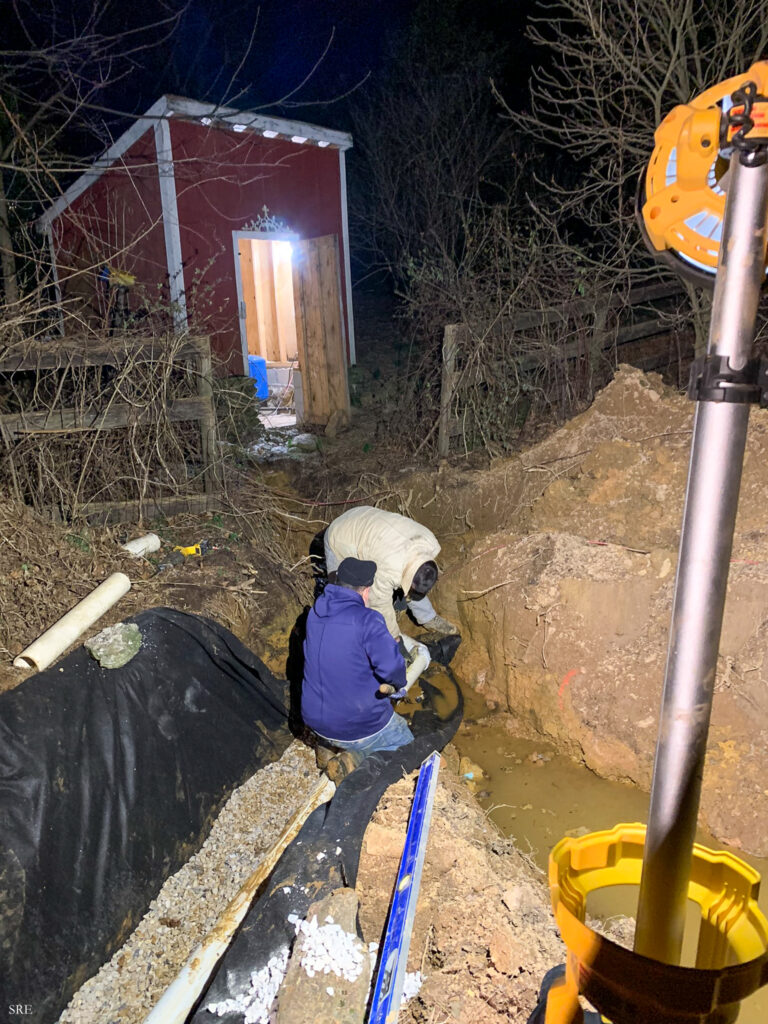
It was the end of March 2023 when we broke ground and removed the existing failed drainage field system and implemented our new drain, which was 4” hard pipe – a schedule 40 PVC all in 10 foot lengths with couplings connectors. The trajectory to the concrete confluence culvert was generally in a strait line, although we did need a 22.5 degree coupling to swing us around to exactly where we needed to terminate. The big factor was putting the proper fall on our new excavated trench. After some math and brainstorming we put 2 feet of total fall on our 120’ run of schedule 40 pipe, we want the water to travel downhill the whole way. Two feet doesn’t sound like too much, but it proved adequate.
Our system was as follows: we excavated a 24” wide trench the whole way with the proper downhill fall of 2 feet, cut and placed our landscape fabric (sometimes aka filter cloth) which was a Super Geo Textile product, 6oz non- woven. On top of that we put down a bed of no. 57 stone (3/4 – 1” diameter limestone), laid our 4” schedule 40 pipe, more stone and wrapped the whole system like a underground burrito. We backfilled, spread grass seed, and used a product called curlex over top the whole disturbance which is a type of top-of-grade earth retainer for erosion control. The installation went well… but the we had to confirm all the water from the springhouse ended up in our new pipe and to the stream. How we did this was a combination of selective demolition and homesteader ingenuity.
The spring water exits the springhouse and briefly collects into a gravel basin about a foot square. It pools a bit and then slips into a 5” cast iron pipe that has been there for quite a long time. This existing outflow pipe we left undisturbed, we then connected our new schedule 40 PVC pipe to this existing 5” diameter pipe with a fernco, which is a flexible coupling connector. This specific one was rated for underground use, not to mention we got lucky as this 5” diameter collection pipe in the gravel trough actually transitioned to 4” down the run which we couldn’t see as it was buried. It was actually a hub on a 4” cast pipe which is besides the point for this conversation other than if you have a cast pipe somewhere and can’t see the whole run, it may transition to a different diameter further down the line.
So again, we ran the whole run of schedule 40 PVC, backfilling as we went upstream toward the springhouse to lastly make the final hookup via fernco to the existing cast iron pipe. Thankfully water immediately flowed through full on and I was finally able to give the two overland water pumps a break (and my electric bill, it took quite some time to devise and schedule this plan of waterway reconnection). We backfilled the last small section and buttoned up the project. It’s been three months since this time of writing and it’s been quite satisfying to know we did our part. In my world anyways, its all about the brookies and whatever water they need in order to propagate.


Some quick thoughts… i’d like to thank those who stuck around to read this all the way thru. I hope it can provide some value to your homesteading endeavors. I’d like to thank Ed Vachino and his team, a fellow conservation minded angler and contractor who specializes in masonry, brick, and stone applications, foundations, concrete and flatwork. Google: Vachino Masonry if youre in the northern Maryland/ south central Pennsylvania region. He was the one who really operationalized this project and got it completed. I just knew I wanted the water back in the stream to the fish. He helped me achieve this. Also, in some places it’s legally sketch to mess with running water, as far as altering the course or changing any of it’s dynamics thru the way, so don’t change anything without contacting the county or taking proper measures locally to understand the laws and overall effects that can result from messing around with drainages. Think how altering one thing may affect the next down the line. It’s a real concern and in aggregate is an issue of conservation. We don’t want to do any detriment to an increasing fragile ecosystem that is our streams, especially those that flow through the machine that is modern farmland practices. In my case, I restored an underground water connection that has been continually running for more than a century and has been in use on the property by previous owners/ occupants since 1765, as per our tax records and documentation on the homestead.
Sean Eagan
Degenerate Angler

